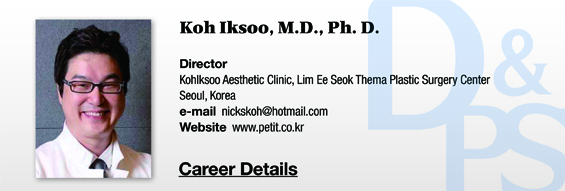The latest trends in dermal fillers
Beginning of dermal fillers
When dermal fillers were first introduced in Korea about 15 years ago, they were mainly used for reducing various facial lines such as the mouth, glabella and nasolabial lines. At the time, nasolabial lines were thought as surface lines and not deeper creases. Filler injections were directed at correcting superficial wrinkles only. Naturally, the effect was minimal and the great potential of filler’s benefit was somewhat overlooked in the earlier days. They were thought to be injections that only corrected visible wrinkles rather than fix the cause.
In this regard, botulinum toxin was a step ahead of fillers. Botulinum toxin had already been extensively studied and its mechanism of action was clearly established. This brought it immediate attention with release. In contrast, the only widely known use for fillers was re-inflating sagging tissues.
[Advertisement] ATLAS(Long pulse 532nm & 940nm dual wavelength) – Manufacturer: MEDRO(www.medro.net)
Advances in filler technology
The era of botulinum toxin began. Its application widened to include the calf reduction and slimming of the jawline. On the other hand, fillers were falling behind.
I also came to use botulinum toxin before fillers. Botulinum toxin was available in only certain university hospitals, however in 1999, Daewoong Pharmaceutical started supplying it to local hospitals. That is how I started to apply botulinum toxin in my practice. Fillers were a second priority to me and they just sat in the hospital’s medical refrigerator. My experience with fillers began with a patient asking for a non-surgical rhinoplasty procedure with a filler. By sheer chance, I began my career in minimally invasive rhinoplasty with fillers. I came to see the potential benefit of fillers through performing non-surgical rhinoplasty and I am still applying fillers to various areas and treatments.
With the advent of non-surgical rhinoplasty that offered effect comparable to surgery, many plastic surgeons including myself and dermatologists started to take interest in fillers. It was found that fillers could be used to not only smooth wrinkles but contour facial features as well.
Fillers could now be used to address not just the surface creases but the deeper structures. But fillers were still far from being a popular procedure. When fillers advanced no further from non-surgical rhinoplasty, fat graft started emerged to popularity.
About a decade ago, fat graft did not enjoy popularity, however, as fat graft was found to re-inflate the forehead, temples and cheek, etc. it started to be widely used. However, as fat was absorbed, the initial volume could not be maintained over time. Fillers were brought in to improve on this shortcoming. There was the problem with the high cost of the filler. Using only 1cc of costly filler could not replace the effect of fat graft. Fortunately, more affordable filler materials have been developed and fillers started to replace fat graft. Currently, fillers can be an effective substitute of fat graft even in areas where 4~5cc injection is needed.
Filler technology has rapidly advanced and one can say that even a science has been established regarding shaping facial features using fillers. In the past, the doctor may have worried about whether to insert the needle perpendicularly or to inject the filler while pulling the needle out. Today, on the contrary, the approach involves causal or anatomical analysis on how the wrinkle develops. APAS is an academic society dedicated to researching the mechanistic and anatomical principles of reducing facial lines with dermal fillers.
Evolution of filler materials
The most popular filler material now is the hyaluronic acid (HA) filler. The collagen filler that was introduced in the early phase had a very short duration of only 3-6 months, therefore, was gradually pushed out of the market. HA filler was released but it also lasted only about 6 months. Two ingredients had to be added to lengthen the duration. A filler containing a mixture of Aquamid and Bio-alcamid and another containing a mixture of HA and dextranomer were developed. When HA is absorbed within 6 months, dextranomer stimulates collagenesis and the effect is maintained.
The duration of HA fillers increased to 2 years thanks to advances in cross linking, polymerizing additives, and processing technologies, etc. The Korean filler market has been dichotomized into HA fillers and permanent fillers. Especially, the HA filler has open patent and anyone can utilize the technology. It seems that HA fillers will continue to lead the market for the foreseeable future.
-To be continued-





















